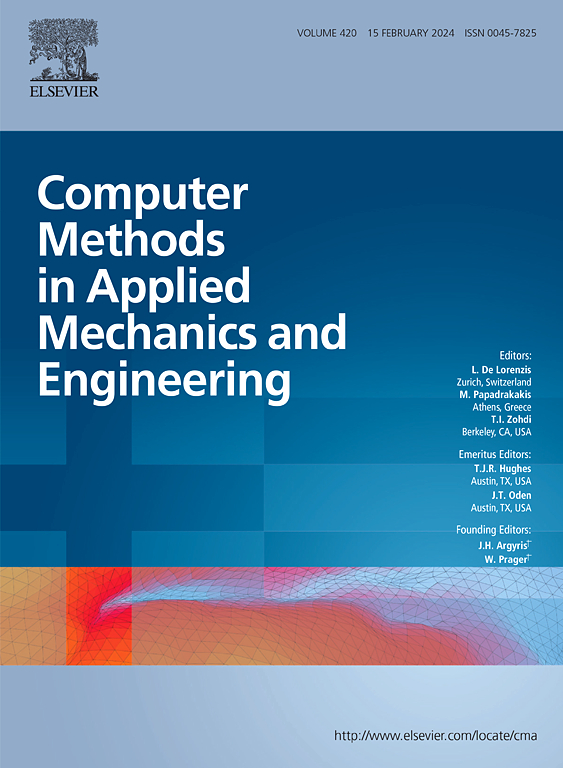A novel energy-fitted hexagonal quadrature scheme enables low-cost and high-fidelity peridynamic computations
IF 6.9
1区 工程技术
Q1 ENGINEERING, MULTIDISCIPLINARY
Computer Methods in Applied Mechanics and Engineering
Pub Date : 2025-03-18
DOI:10.1016/j.cma.2025.117918
引用次数: 0
Abstract
In this contribution, we propose a novel hexagonal quadrature scheme for one-neighbor interactions in continuum-kinematics-inspired peridynamics equivalent to bond-based peridynamics. The hexagonal quadrature scheme is fitted to correctly integrate the stored energy density within the nonlocal finite-sized neighborhood of a continuum point subject to affine expansion. Our proposed hexagonal quadrature scheme is grid-independent by relying on appropriate interpolation of pertinent quantities from collocation to quadrature points. In this contribution, we discuss linear and quadratic interpolations and compare our novel hexagonal quadrature scheme to common grid-dependent quadrature schemes. For this, we consider both, tetragonal and hexagonal discretizations of the domain. The accuracy of the presented quadrature schemes is first evaluated and compared by computing the stored energy density of various prescribed affine deformations within the nonlocal neighborhood. Furthermore, we perform three different boundary value problems, where we measure the effective Poisson’s ratio resulting from each quadrature scheme and evaluate the deformation of a unit square under extension and beam bending. Key findings of our studies are: The Poisson’s test is a good indicator for the convergence behavior of quadrature schemes with respect to the grid density. The accuracy of quadrature schemes depends, as expected, on their ability to appropriately capture the deformation within the nonlocal neighborhood. Our novel hexagonal quadrature scheme, rendering the correct effective Poisson’s ratio of for small deformations, together with quadratic interpolation consequently yields the most accurate results for the studies presented in this contribution, thereby effectively reducing the computational cost.
一种新的能量拟合六边形正交方案实现了低成本和高保真的周动力计算
在这篇贡献中,我们提出了一种新的六边形正交格式,用于连续运动学启发的周动力学中的单邻居相互作用,相当于基于键的周动力学。拟合了六边形正交格式,以正确地积分受仿射展开的连续点的非局部有限尺寸邻域内的存储能量密度。我们提出的六边形正交方案依赖于从配点到正交点的相关量的适当插值,是网格无关的。在这篇文章中,我们讨论了线性插值和二次插值,并将我们的新六边形正交格式与常见的网格依赖正交格式进行了比较。为此,我们考虑了区域的四边形和六边形离散化。首先通过计算非局部邻域内各种规定仿射变形的存储能量密度来评价和比较所提出的正交格式的精度。此外,我们执行了三个不同的边值问题,其中我们测量了由每个正交方案产生的有效泊松比,并评估了单位正方形在拉伸和梁弯曲下的变形。本研究的主要发现是:泊松检验很好地反映了正交格式对网格密度的收敛性。正如预期的那样,正交方案的准确性取决于它们在非局部邻域内适当捕获变形的能力。我们新颖的六边形正交方案,对于小的变形呈现正确的有效泊松比为1/3,再加上二次插值,因此为本贡献的研究提供了最准确的结果,从而有效地降低了计算成本。
本文章由计算机程序翻译,如有差异,请以英文原文为准。
求助全文
约1分钟内获得全文
求助全文
来源期刊
CiteScore
12.70
自引率
15.30%
发文量
719
审稿时长
44 days
期刊介绍:
Computer Methods in Applied Mechanics and Engineering stands as a cornerstone in the realm of computational science and engineering. With a history spanning over five decades, the journal has been a key platform for disseminating papers on advanced mathematical modeling and numerical solutions. Interdisciplinary in nature, these contributions encompass mechanics, mathematics, computer science, and various scientific disciplines. The journal welcomes a broad range of computational methods addressing the simulation, analysis, and design of complex physical problems, making it a vital resource for researchers in the field.

 求助内容:
求助内容: 应助结果提醒方式:
应助结果提醒方式:


